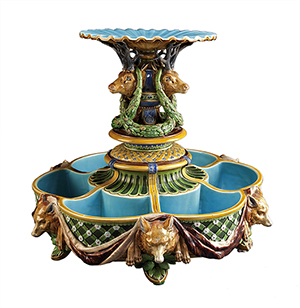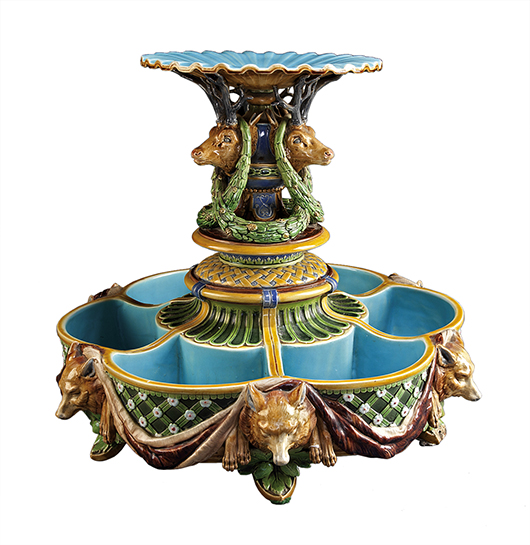
BEACHWOOD, Ohio – A Minton majolica centerpiece was auctioned in May as an “ice stand.” Minton & Polson was established in 1793 in Stoke-on-Trent, Staffordshire, England. The company started making majolica in about 1850. Some of these early pieces, marked “Minton,” inspired majolica made after 1873, when the company often used the mark “Mintons.” Ice stands were pictured in the company’s 1851 catalog. They were tall pieces meant to be used as spectacular centerpieces on a dining table. Each was a tall pedestal with a vase or dish-shaped piece at the top, a large “stem” and a group of small bowls or plates surrounding the pedestal, sometimes at two levels. The stands held ice or ice shavings and sauces for dessert. But as one expert has said, they were “more ornamental than functional.” An 1865 Minton ice stand decorated with stag heads, wolves and pine cones sold for $8,610 at a May 2013 Neal auction in New Orleans.
Q: For years my family has owned an antique spool bed (the kind with spool-turned head and foot boards). Everyone always called it a “Jenny Lind bed.” Please tell me why.
A: Jenny Lind (1820-1887) was a world-famous opera singer known as the “Swedish Nightingale.” She became a huge celebrity in the United States when she toured here in 1850-’52 at the invitation of P.T. Barnum, a master promoter. American advertisers used her to promote everything from hats and gloves to pianos and beds. Lind is said to have slept in a spool-turned bed while on the tour—so furniture makers started calling the popular style a “Jenny Lind bed.” The style still is often advertised that way.
Q: I have inherited a picture of what looks like an oil painting. There are two buildings in it, one with a “Morton Salt” sign. The picture is signed “H. Hargrove” and has a round seal on the back with a number and the phrase, “Collectors Corner, Inc., Certificate of Authenticity.” Is it worth much?
A: “H. Hargrove” is a name used by painter Nicolo Sturiano. He was born in Italy in 1941 and came to the United States in 1964. He worked as a winemaker at a New York State vineyard while he began painting as a hobby. When his nostalgic American landscapes became popular, he left the vineyard and moved to Greenwich Village in New York City. Collectors Corner of Indianapolis sold Hargrove prints in the 1980s through a home party plan. Hargrove is still working and has a studio in Toms River, N.J. Your limited-edition print sells for $25 or less.
Q: My father-in-law died in 1962 and left a bottle of Chivas Regal 12 Year Old blend. It has never been opened and has all the stamps required at the time. Does it have any value other than the normal price today?
A: James and John Chivas began making blended whiskey in Aberdeen, Scotland, in the mid-19th century. The Chivas Regal 12 Year Old Blend was introduced in 1938. The Chivas Regal brand was bought by Pernod Ricard, a French group, in 2001. Full bottles of liquor should be kept in a cool, dark place, but even with proper storage, the liquor may deteriorate after a few years. Full bottles can’t be sold privately in some states. You could open the bottle and drink the whiskey, although if it was stored in a hot or sunny place, the taste may have changed. Modern liquor bottles have very little resale value.
Q: I have a hanging scale marked “Patented Aug. 19, 1884, makers of balances and scales of every description, John Chatillon & Sons, New York.” It also reads “Butcher’s scale,” and has numbers from zero to nine on the dial. Can you give me any information about this?
A: John Chatillon & Sons was founded in New York City in 1835. The company made spring balances for butchers. By 1883 it was making balances, scales, cutlery and other goods. The Chatillon brand is now owned by Ametek Inc., based in Berwyn, Pa. It still makes springs and scales, as well as other force-measuring instruments for industry. Value of your scale is about $50 to $75.
Q: In late 1982, my husband bought a small Timex personal computer for $105 (including taxes). We still have the computer, without its box, and the original receipt. He used it exactly once. Should I keep it or toss it?
A: You have a “Timex Sinclair 1000” computer. It was the first computer produced by Timex Sinclair, a joint venture of Timex Corp., a U.S. company, and Sinclair Research of England. The computer was sold as “the first computer under $100.” Timex lost out to competitors like Commodore, Atari and Apple, and dropped out of the computer market in early 1984. Timex Sinclair 1000s frequently are offered for sale online. Prices range from about $40 to well over $200. So, rather than tossing the computer, you might want to recoup some of your money by selling it. You can learn more about Timex Sinclair computers at OldComputers.net, a site dedicated to obsolete technology.
Tip: Never wrap a painting in bubble wrap so that the wrap touches the painted surface. In time, the plastic will leave marks.
Terry Kovel answers as many questions as possible through the column. By sending a letter with a question, you give full permission for use in the column or any other Kovel forum. Names, addresses or email addresses will not be published. We cannot guarantee the return of any photograph, but if a stamped envelope is included, we will try. The volume of mail makes personal answers or appraisals impossible. Write to Kovels, Auction Central News, King Features Syndicate, 300 W. 57th St., New York, NY 10019.
CURRENT PRICES Current prices are recorded from antiques shows, flea markets, sales and auctions throughout the United States. Prices vary in different locations because of local economic conditions.
- Hummel figurine, boy with toothache, missing bee mark, no. 217/2, 5 1/2 inches, $50.
- Consolidated Glass vase, blue, impressed tropical fish, 8 1/2 x 6 3/4 inches, $75.
- Shelley cup and saucer, Rock Garden pattern, gilt handle and foot, c. 1940, $125.
- Pressed glass cake stand, Holly pattern, 9 inches, $145.
- Meissen figurine, cupid forging heart with anvil, 7 x 3 inches, $295.
- Sewer tile, figural lion, molded, unglazed, oval base, Mogadore, Ohio, 9 x 15 inches, $380.
- Porcelain plate, Sevres style, aristocratic woman, rose garland in hair, cobalt border, reserves, 10 1/2 inches, $875.
- Newcomb bowl, Japanese quince, relief carved, blue, green, pink, Anna Frances Simpson, 1919, 5 7/8 inches, $895.
- Monastery doorbell, cast iron, figural monk ringer, c. 1850, 35 1/2 inches, $1,540.
- Fireplace fender, cast iron, brass, arches, paw feet, England, 1800s, 9 x 38 1/2 inches, $4,480.
The best book to own if you want to buy, sell or collect—and if you order now, you’ll receive a copy with the author’s autograph. The new Kovels’ Antiques & Collectibles Price Guide, 2014, 46th edition, is your most accurate source for current prices. This large-size paperback has more than 2,500 color photographs and more than 35,000 up-to-date prices for more than 700 categories of antiques and collectibles. You’ll also find hundreds of factory histories and marks and a report on the record prices of the year, plus helpful sidebars and tips about buying, selling, collecting and preserving your treasures. Available online at Kovelsonlinestore.com; by phone at 800-303-1996; at your bookstore; or send $27.95 plus $4.95 postage to Price Book, P.O. Box 22900, Beachwood, OH 44122.
© 2013 by Cowles Syndicate Inc.

ADDITIONAL IMAGE OF NOTE


